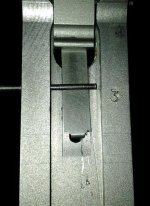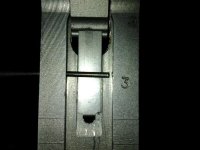Just to cover the bases, does the new-to-you/used "6906" list the model as 6906 on the left side of the frame? Or is it a 6946?
Is there a left side manual safety lever? (Granted, the answer to this question may not be definitive if someone had an older 6906 converted to DAO with the new-style DAO parts, and decided to keep the manual safety.)
A 6946 (old-style DAO), or a 6906 converted to DAO with new style parts (so they fit & function in the TDA frame & slide), would naturally have the hammer go forward to the "located" position as the gun fires with each trigger press and the slide cycles (once the hammer is initially "located" by retracting the slide to "charge" the pistol). BTW, the new style DAO MIM parts (hammer, sear & trigger) CANNOT be mixed with the old-style DAO non-MIM parts. Not at all.
A S&W TDA pistol (traditional double action, or DA/SA), as you're familiar with in your original 6906, it seems, ought to have the hammer remain in the single action cocked condition after the slide is cycled (after an initial DA shot).
If the hammer follows the slide in a TDA model, it's
typically due to one or more of these conditions:
Damaged Sear Spring
Damaged Sear
Damaged single action cocking notch on hammer
Odd things can happen, though. I had a fairly new (3 yrs old?) 4566TSW brought to me for complaints of the hammer not holding in single action during a qual course-of-fire. When I inspected the gun I found it was really gummed up inside the frame, all around the hammer, sear & drawbar. It was obviously caused by an excessive (and repeatedly applied) amount of solvent/lubricant, probably occurring during some repeated cleanings. The sear wasn't able to consistently & freely move back and catch the hammer's single action cocking notches, and the hammer started falling and following the slide. Not good, as the hammer following the slide can result in doubling & "bursts". This was probably caught just in time, all the way around.
Once cleaned up, so I could see the parts clearly

, they all appeared to be in normal condition and the gun passed all bench checks for normal functioning. Returning the cleaned and normally lubed gun to the firing line, having it fired by both the issued user and the instructor who had observed the original problem, the gun now demonstrated normal function. (I discussed & stressed the importance of proper cleaning & lubrication practices, BTW.)
Also, a S&W TDA gun may decock upon
firing (even with the manual safety in the off-safe/ready-to-fire position) if the wrong spring is installed in the decocker body. The decocking lever assembly can rotate when the slide hits the rear of its travel, during live-fire, unless the proper spring is used underneath the decocker body plunger.
Naturally, no way to know what's happening with
your used "6906" without being there to examine it, but those are just some thoughts off the top of my head.
You really need to determine if this is a DAO gun (and acting normally), or whether it requires the attention & services of a gunsmith familiar with S&W TDA guns.


